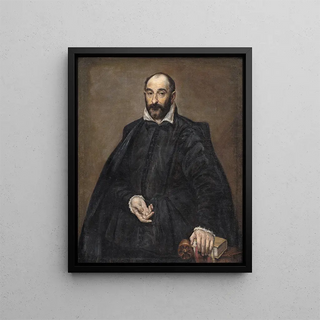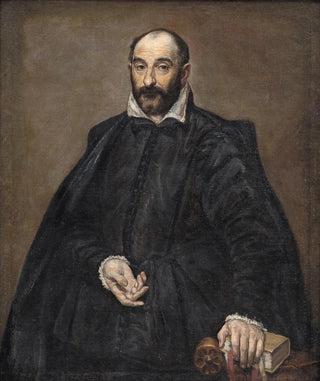Art print | Portrait of a man - El Greco


View from behind

Frame (optional)
Portrait of a Man - El Greco – Captivating Introduction
The "Portrait of a Man," an iconic work by El Greco, transcends mere facial features to serve as a true window into the human soul. Created at the end of the 16th century, this painting embodies the very essence of Mannerism, an artistic movement distinguished by its expressiveness and boldness. The artist, whose real name is Domenikos Theotokopoulos, masterfully captures not only the physical appearance of his subject but also a psychological depth that invites viewers to reflect on the identity and status of the depicted individual. This artwork, through its technique and style, continues to inspire interest and admiration among art enthusiasts across the centuries.
Style and uniqueness of the work
El Greco's style is characterized by a daring use of colors and elongated forms, creating an atmosphere that is both mystical and dramatic. In the "Portrait of a Man," the subject's face is illuminated by a soft light, emphasizing the pronounced features and the depth of the eyes. The color palette, oscillating between dark tones and luminous highlights, enhances the impression of emotional intensity. This chromatic choice, combined with virtuoso brushstrokes, gives the piece a unique dynamism. The drapery of the clothing, although dark, seems to vibrate under the effect of light, adding an almost sculptural dimension to the composition. This blend of realism and abstraction makes this work a perfect example of how El Greco manages to fuse the tangible and the spiritual.
The artist and his influence
El Greco, born in Crete and having found his path in Toledo, left a mark on his era through an innovative approach that influenced many artists. His distinctive style, blending Byzantine influences with elements of the Italian Renaissance, paved the way for a new way of perceiving painting. El Greco's contemporaries, although fascinated by his talent, did not always understand the depth of his art. However, over time, his work was rediscovered and recognized for its originality. Artists such as Picasso and Soutine

Matte finish

View from behind

Frame (optional)
Portrait of a Man - El Greco – Captivating Introduction
The "Portrait of a Man," an iconic work by El Greco, transcends mere facial features to serve as a true window into the human soul. Created at the end of the 16th century, this painting embodies the very essence of Mannerism, an artistic movement distinguished by its expressiveness and boldness. The artist, whose real name is Domenikos Theotokopoulos, masterfully captures not only the physical appearance of his subject but also a psychological depth that invites viewers to reflect on the identity and status of the depicted individual. This artwork, through its technique and style, continues to inspire interest and admiration among art enthusiasts across the centuries.
Style and uniqueness of the work
El Greco's style is characterized by a daring use of colors and elongated forms, creating an atmosphere that is both mystical and dramatic. In the "Portrait of a Man," the subject's face is illuminated by a soft light, emphasizing the pronounced features and the depth of the eyes. The color palette, oscillating between dark tones and luminous highlights, enhances the impression of emotional intensity. This chromatic choice, combined with virtuoso brushstrokes, gives the piece a unique dynamism. The drapery of the clothing, although dark, seems to vibrate under the effect of light, adding an almost sculptural dimension to the composition. This blend of realism and abstraction makes this work a perfect example of how El Greco manages to fuse the tangible and the spiritual.
The artist and his influence
El Greco, born in Crete and having found his path in Toledo, left a mark on his era through an innovative approach that influenced many artists. His distinctive style, blending Byzantine influences with elements of the Italian Renaissance, paved the way for a new way of perceiving painting. El Greco's contemporaries, although fascinated by his talent, did not always understand the depth of his art. However, over time, his work was rediscovered and recognized for its originality. Artists such as Picasso and Soutine






